Josia
James S. Miller and Andrew V. Z. Brower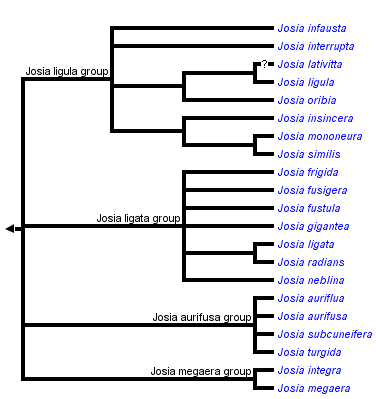


This tree diagram shows the relationships between several groups of organisms.
The root of the current tree connects the organisms featured in this tree to their containing group and the rest of the Tree of Life. The basal branching point in the tree represents the ancestor of the other groups in the tree. This ancestor diversified over time into several descendent subgroups, which are represented as internal nodes and terminal taxa to the right.

You can click on the root to travel down the Tree of Life all the way to the root of all Life, and you can click on the names of descendent subgroups to travel up the Tree of Life all the way to individual species.
For more information on ToL tree formatting, please see Interpreting the Tree or Classification. To learn more about phylogenetic trees, please visit our Phylogenetic Biology pages.
close boxIntroduction
The genus Josia was formerly included a heterogeneous assemblage of 67 superficially similar species, but has been circumscribed to include a monophyletic group of only 21 species by Miller (2009). The remaining species have been removed to Lyces, Ephialtias, Proutiella, and other related genera. Josia spp. occur from Mexico to Uruguay, and may be the most common dioptines. Life histories of ten species are known, and all feed on Passiflora, except for the megeara clade, whose larvae feed on Turnera.
Characteristics
Josia spp. almost all have wings with characteristic radial orange bands on a black background, and orange stripes on the abdominal pleura. The abdominal venter is usually white or cream-colored. There are structural features of the wing venation, labial palpi and genitalia that distinguish Josia from related genera, as well. Venation of J. mononeura and J. ligula are illustrated below.

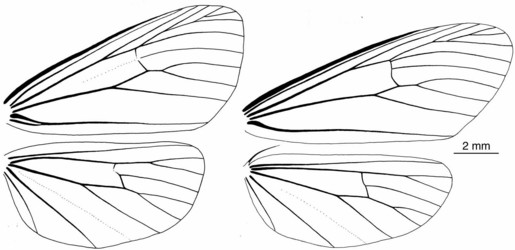
Josia mononeura (left) and Josia ligula (right). © 2009 James S. Miller
Species groups in Josia may be distinguished as follows:
- the ligula group exhibits diverse wing patterns, but all possess a unique process on the midpoint of the costa of the male valvae
- the ligata group all possess yellow-orange scales on the basal half of the forewing costal margin
- the aurifusa group all exhibit an orange anal margin of the hindwing
- the megeara group exhibits a distal transverse orange band and basal radial stripe on the forewings, forming two separate pattern elements
References
Miller, JS. 2009. Generic revision of the Dioptinae (Lepidoptera: Noctuoidea: Notodontidae). Bulletin of the American Museum of Natural History 321, 1-971 + 48 plates.
Title Illustrations

| Scientific Name | Josia radians |
|---|---|
| Location | Venezuela: Mérida, Carr. Estanquez - Las Coloradas, 1130 m. |
| Comments | reared from eggs of wild-caught female |
| Reference | Miller JS. 2009. Generic revision of the Dioptinae (Lepidoptera: Noctuoidea: Notodontidae). Bulletin of the American Museum of Natural History 321, 1-971 + 48 plates. (Plate 32) |
| Specimen Condition | Dead Specimen |
| Identified By | James S. Miller |
| Sex | Male |
| Life Cycle Stage | adult |
| View | dorsal |
| Collection | AMNH |
| Collector | L. Daniel Otero |
| Image Use |
 This media file is licensed under the Creative Commons Attribution License - Version 3.0. This media file is licensed under the Creative Commons Attribution License - Version 3.0.
|
| Copyright |
© 2009

|
| Scientific Name | Josia aurifusa |
|---|---|
| Location | Venezuela: Mérida, Puente Victoria, Carretera Mérida - El Vigía, 540 m. |
| Comments | ex egg on Passiflora capsularis |
| Reference | Miller JS. 2009. Generic revision of the Dioptinae (Lepidoptera: Noctuoidea: Notodontidae). Bulletin of the American Museum of Natural History 321, 1-971 + 48 plates. (Plate 32) |
| Specimen Condition | Dead Specimen |
| Identified By | James S. Miller |
| Sex | Female |
| Life Cycle Stage | adult |
| View | dorsal |
| Collection | AMNH |
| Collector | L. D. Otero |
| Image Use |
 This media file is licensed under the Creative Commons Attribution License - Version 3.0. This media file is licensed under the Creative Commons Attribution License - Version 3.0.
|
| Copyright |
© 2009

|
About This Page

Middle Tennessee State University, Murfreesboro, Tennessee, USA
Correspondence regarding this page should be directed to James S. Miller at and Andrew V. Z. Brower at
Page copyright © 2010 and
 Page: Tree of Life
Josia .
Authored by
James S. Miller and Andrew V. Z. Brower.
The TEXT of this page is licensed under the
Creative Commons Attribution-NonCommercial License - Version 3.0. Note that images and other media
featured on this page are each governed by their own license, and they may or may not be available
for reuse. Click on an image or a media link to access the media data window, which provides the
relevant licensing information. For the general terms and conditions of ToL material reuse and
redistribution, please see the Tree of Life Copyright
Policies.
Page: Tree of Life
Josia .
Authored by
James S. Miller and Andrew V. Z. Brower.
The TEXT of this page is licensed under the
Creative Commons Attribution-NonCommercial License - Version 3.0. Note that images and other media
featured on this page are each governed by their own license, and they may or may not be available
for reuse. Click on an image or a media link to access the media data window, which provides the
relevant licensing information. For the general terms and conditions of ToL material reuse and
redistribution, please see the Tree of Life Copyright
Policies.
- First online 04 December 2009
- Content changed 04 December 2009
Citing this page:
Miller, James S. and Andrew V. Z. Brower. 2009. Josia . Version 04 December 2009 (under construction). http://tolweb.org/Josia/138591/2009.12.04 in The Tree of Life Web Project, http://tolweb.org/




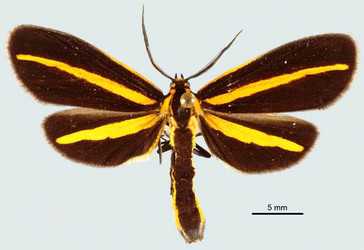
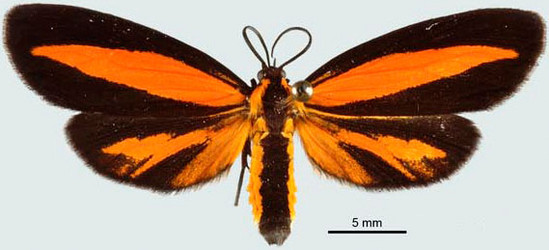
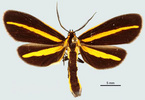


 Go to quick links
Go to quick search
Go to navigation for this section of the ToL site
Go to detailed links for the ToL site
Go to quick links
Go to quick search
Go to navigation for this section of the ToL site
Go to detailed links for the ToL site